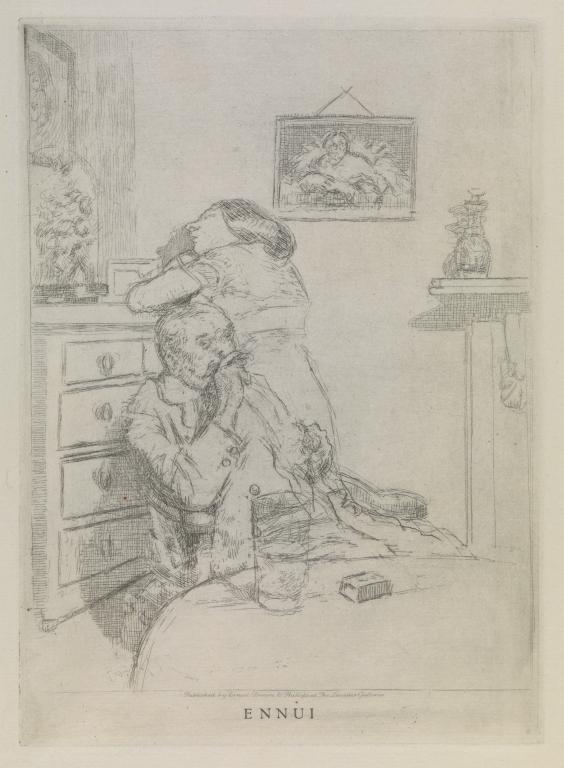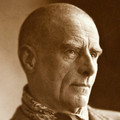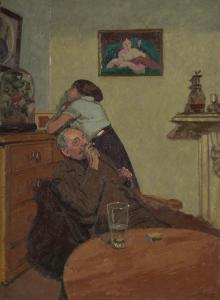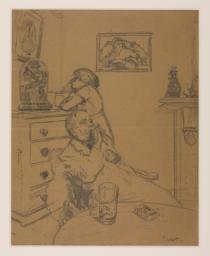Walter Richard Sickert Ennui 1914-5, published 1929
Walter Richard Sickert,
Ennui
1914-5, published 1929
In this medium plate etching, the figure of Hubby is turned slightly more towards the viewer than in the oil painting (Tate N03846) and more stubble is visible on his face. After Ennui debuted successfully at the New English Art Club in 1914, Sickert included an etching of the popular picture in his Carfax Gallery series. He continued to revise the design and this print was later published by the Leicester Galleries in 1929.
Walter Richard Sickert 1860–1942
Ennui
1914–15, published 1929
Etching
226 x 162 mm, on paper 360 x 263 mm, with plate mark 226 x 164 mm
Inscribed in engraved italics ‘Published by Ernest Brown & Phillips at The Leicester Galleries’ below image at centre; inscribed in engraved text ‘ENNUI’ below
Bequeathed by Mrs E. West 1982
P11050
1914–15, published 1929
Etching
226 x 162 mm, on paper 360 x 263 mm, with plate mark 226 x 164 mm
Inscribed in engraved italics ‘Published by Ernest Brown & Phillips at The Leicester Galleries’ below image at centre; inscribed in engraved text ‘ENNUI’ below
Bequeathed by Mrs E. West 1982
P11050
Ownership history
... ; Mrs E. West, by whom bequeathed to Tate Gallery 1982.
References
1978
Sickert: Etchings and Drypoints, exhibition catalogue, Victoria and Albert Museum, London 1978, pp.2, 8.
1988
Prints by Walter Richard Sickert (1860–1942), exhibition catalogue, Gordon Cooke, London 1988, nos.9–10.
1989
W.R. Sickert: Drawings and Paintings 1890–1942, exhibition catalogue, Tate Gallery, Liverpool 1989, p.24.
2000
Ruth Bromberg, Walter Sickert Prints: A Catalogue Raisonné, New Haven and London 2000, pp.185–6, no.156.6, reproduced.
2002
Sickert: Pages Torn from the Book of Life, exhibition catalogue, Fine Art Society, New York 2002, p.47, reproduced no.34.
2004
Ruth Bromberg, ‘Ennui: Etching as Drawing’, in Walter Sickert: ‘drawing is the thing’, exhibition catalogue, Whitworth Art Gallery, Manchester 2004, p.16.
Technique and condition
Ennui is a hard ground etching on off-white laid paper with a prominent watermark in the lower left corner. The paper is generally in good condition, but there are some dirty printer’s fingermarks in the top margin, which are normally covered by the window mount. The presence of the title and publisher’s credits below the image suggest that this is not a trial proof. However, the uneven plate tone, the anaemic quality of the image and the lack of an edition number indicate that this is not an official proof. It is possible that this print was made by an amateur who somehow had access to the plate or more likely by the artist himself.
Piers Townshend
December 2010
How to cite
Piers Townshend, 'Technique and Condition', December 2010, in Nicola Moorby, ‘Ennui 1914–15, published 1929 by Walter Richard Sickert’, catalogue entry, May 2004, in Helena Bonett, Ysanne Holt, Jennifer Mundy (eds.), The Camden Town Group in Context, Tate Research Publication, May 2012, https://wwwEntry
Printmaking was an extremely important part of Walter Sickert’s oeuvre. A comprehensive understanding and appreciation of Sickert’s achievements has only recently become possible through the research of certain scholars, particularly Aimée Troyen and Ruth Bromberg.1 Sickert learned the craft of etching from his mentor, James Abbott McNeill Whistler (1834–1903), and over his lifetime produced at least 226 prints.
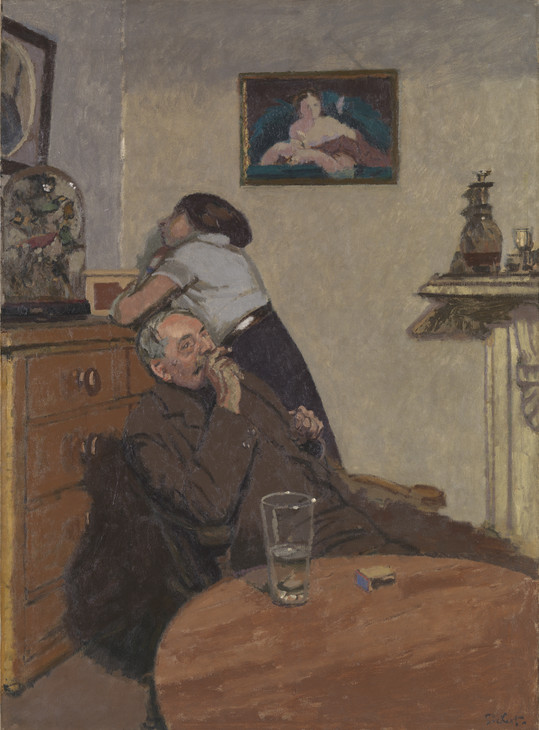
Walter Richard Sickert 1860–1942
Ennui c.1914
Oil paint on canvas
support: 1524 x 1124 mm; frame: 1741 x 1340 x 110 mm
Tate N03846
Presented by the Contemporary Art Society 1924
© Tate
Fig.1
Walter Richard Sickert
Ennui c.1914
Tate N03846
© Tate
Sickert produced three separate sized etched versions of his most famous image, Ennui: a large plate, a medium plate and a small plate.2 The appearance and details of all three sizes of print are derived from Tate’s version of Ennui, by way of a working drawing in pencil, pen and brown ink, blue and red chalks (Whitworth Art Gallery, Manchester).3 The dimensions of the Whitworth drawing correspond to those of the large etched plate that Ruth Bromberg maintains was a preparatory study for the two smaller versions.4 Bromberg’s catalogue raisonné of prints by Sickert reveals Tate’s etching to be an impression of the sixth state of the second size, the medium plate. In this version, the figure of Hubby is more upright and turned slightly more towards the viewer than in the painting or the other etchings. There is also more stubble on his face. The figure of Marie seems to lean on her right arm more than the chest and she lacks her black belt. There is also no wine glass beside the decanter on the mantelpiece.
According to Bromberg, Ennui (The Medium Plate) was commenced in 1914–15 but remained unfinished for a number of years.5 In 1925 an impression of the first state was exhibited at the Leicester Galleries. Sickert subsequently carried out a number of changes and the plate went through five stages before the sixth and final impression incorporating the engraved inscription, ‘Published by Ernest Brown & Phillips at The Leicester Galleries’, was advertised in Artwork Quarterly Catalogue of Prints in 1929.
Nicola Moorby
May 2004
Notes
Aimée Troyen, Walter Sickert as Printmaker, exhibition catalogue, Yale Center for British Art, New Haven 1979 and Ruth Bromberg, Walter Sickert Prints: A Catalogue Raisonné, New Haven and London 2000.
Related biographies
Related essays
- After Camden Town: Sickert’s Legacy since 1930 Martin Hammer
- Questions of Artistic Identity, Self-Fashioning and Social Referencing in the Work of the Camden Town Group Andrew Stephenson
- Walter Sickert and Contemporary Drama William Rough
- From Drawing Room to Scullery: Reading the Domestic Interior in the Paintings of Walter Sickert and the Camden Town Group Juliet Kinchin
- The Evolution of Painting Technique among Camden Town Group Artists Stephen Hackney
- The Camden Town Group: Then and Now Ysanne Holt
Related catalogue entries
How to cite
Nicola Moorby, ‘Ennui 1914–15, published 1929 by Walter Richard Sickert’, catalogue entry, May 2004, in Helena Bonett, Ysanne Holt, Jennifer Mundy (eds.), The Camden Town Group in Context, Tate Research Publication, May 2012, https://www

